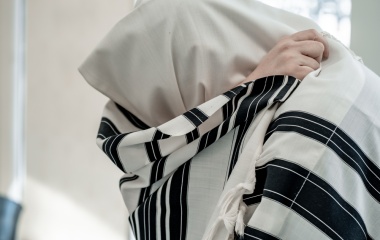
Originally meant as an oral “text” the Talmud features a number of mnemonic devices to aid in recall and memorization. Thus unrelated topics may be grouped together because of similarities in language. Probably the most famous of these is a series of ein beins found in the Mishna of the first chapter of masechet Megillah. After teaching that ein bein, there is no difference between Adar 1 and Adar 2 save for the requirement “to read the Megillah and gifts to the poor” the Mishna lists a further twelve ein beins detailing relatively minor differences between two areas of Jewish law; Shabbat and Yom Tov, Shabbat and Yom Kippur, tefillin, mezuzah and other holy texts, Shiloh and Jerusalem to name a few.
In a similar vein the Gemara often records a string of teachings given by the same amora (Talmudic sage). While these are often explained as a mnemonic device more often than not the teachings themselves are also, if you scratch a little deeper, connected. Hence we rarely bring all the teachings of a selected Sage, rather only those few that have some connection to each other.
As we celebrate Chanukah we need look no further than two teachings of Rav Tanchum - or more precisely Rav Kahana quoting Rav Natan bar Minyomi who expounded in the name of Rav Tanchum. The first is that Chanuka candles must be placed within 20 amot (approximately 30 feet) from the ground. This is followed by his teaching regarding the pit into which the brothers threw Yosef. As the Torah tells us that the pit was “empty” what need was there to say “it had no water”? Rav Tanchum answers that it teaches “water it did not have, but snakes and scorpions it did have” (Shabbat 22a). Seemingly what links these two teachings is the name and the name only. This is especially so where these are the only two teaching of Rav Kahana in the name of Rav Natan bar Minyomi who expounds in the name of Rav Tanchum. Yet these teaching are related.
Chanukah candles placed too high are not noticeable defeating the purpose of lighting - publicizing the miracle. It is this problem of not noticing which is highlighted in the Yosef story. Yosef was thrown into the pit at the behest of Reuven who wanted to save Yosef. If so why would he throw him into a pit with snakes and scorpions? It must be that the brothers just did not see the snakes and scorpions.
Chanukah candles placed too high are not noticeable defeating the purpose of lighting - publicizing the miracle. It is this problem of not noticing which is highlighted in the Yosef story. Yosef was thrown into the pit at the behest of Reuven who wanted to save Yosef. If so why would he throw him into a pit with snakes and scorpions? It must be that the brothers just did not see the snakes and scorpions.
At the same time we often find a series of teaching by a particular sage all on the same topic. Often Sages specialized in certain topics. We know some were expert on halacha others in agadah and within the broad topics of halacha we have many sub-specialties. I seem to recall hearing in the name of the Vilna Gaon that each masechet features one Sage who appears in that particular and only in that particular masechet (I would be grateful if someone shared this source.)
The Mishna continuing the discussion on language teaches that birchat kohanim must be said in Hebrew. “Ko tivarcho” - this is how you should bless i.e. it must be exactly like this. As the Gemara discusses the laws of birchat kohanim Rabbi Yehoshua ben Levi has a series of teachings relating to birchat kohanim which then segue into the related teachings relating to generosity of spirit. Let us discuss some of them.
“How do we know that the Holy One Blessed be He mitaveh, yearns,for the priestly benediction? As it is says: ‘So shall they put My name upon the children of Israel; and I will bless them’” (Sotah 38b). G-d yearns for one Jew to bless another and when that happens G-d can then bestow His own blessings upon us. It is as if G-d can only bless us if we bless our fellow Jew.
And when we bless others we ourselves are blessed as Rav Yehoshua ben Levi’s next teaching indicates, “every kohen who blesses is blessed”. The word to give, venatnu, is a palindrome indicating that what we get is a function of what we give. To give up a chance to bless is sinful as Rav Yehoshua ben Levi continues; “any kohen who does not ascend the platform [to bless the people] violates three commands”.
In life timing is everything thus Rav Yehoshua ben Levi teaches: “a kohen who does not ascend by the blessing of avodah (retze) may no longer ascend. The bracha of avodah marks the beginning of the last of the three sections of the shemoneh esrei coming on the heels of the 13 blessings of petition. Prayer is essentially petitioning G-d to fulfill our needs. But before we finish this section of the shemoneh esrei we must begin the process of blessing others. We cannot begin to be thankful for what we have without being cognizant of the need to share with others. And we must do so with joy.
Such joy is not to be limited to the kohanim. “Rav Yehoshua ben Levi said: We give the cup of blessing for the recital of the Grace after meals only to one who is of a generous disposition”. A blessing is not a series of words but an attitude and a blessing given begrudgingly is no blessing. It is for this reason the kohanim are to bless us beahava, with love. The RaMaH (Orach Chaim 128:43) quotes a custom that those observing the twelve month mourning period for their parents may not offer the priestly blessing. Such mourning interferes with the joy needed to bless others[1].
Sharing our blessings lovingly with others is as good a recipe for long life as any other. “The students asked Rabbi Elazar ben Shamua - through what did you merit long days? He said to them... and I did not lift my hands [to bless the people] without reciting a blessing” (Sotah 39a). It is most unlikely Rav Elazar felt his long life was due to making a blessing - if so any blessing could do. It was specifically the blessing of birchat kohanim which by definition can only be done with love that he felt was the cause of length of days.
____________________
____________________
[1] The obligation to bless the people is a daily one. Nonetheless the RaMaH (128:44) explains that “in our countries” the custom is that birchat kohanim is done only on Yom Tov when we are in a joyous mood - as opposed to other times including Shabbat when people are “busy thinking about their sustenance”. This is a fascinating ruling both halachically and historically.


